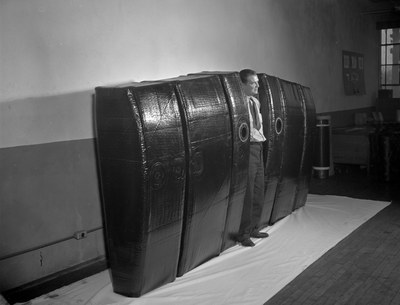
Plan your visit
Figuring Out a Foster Photograph
September 28, 2016

Getting the identifications of images right is something we take seriously. Sometimes it’s more difficult than others. Sometimes it seems impossible. We learn to live with the fact that many people don’t label family photographs many landscapes are impossible to pin down, and we can’t memorize the business districts of every town in Indiana. We can’t be experts in everything about the history of Indiana. But still, just preserving the photographs isn’t enough.
We want you to be able to find what you want and we want to show you what you don’t yet know you want to see. This can be frustrating. After feeling like I had exhausted the possibilities of identifying a photograph of a church sanctuary, I tried to put it out of my mind. However, a retired professor and long-time researcher came to my rescue. He happened into the Library one afternoon and, upon request, looked thoughtfully at the photograph. He wasn’t sure, but said he’d keep it in mind. Just a few minutes later, he beckoned me over and showed me a passage in the book he was reading that confirmed the location Sisters of the Good Shepherd convent.
Some images just cry out to be identified, too. I was looking at a series of photographs Larry Foster took for U.S. Rubber Company and saw one that was very puzzling. What could these objects be that a man posed with up against a wall? Knowing that the company did “war work,” made us think these could have been components for a ship or aircraft. We couldn’t get beyond conjecture, though. With the help of our marketing department, we turned to social media. Within a very short time of posting it, the responses came in. With the information provided we were able to identify the objects as rubber fuel tank liners.
One of the dangers of aerial warfare is fire caused by bullets entering and exiting the fuel tanks. As bullets exited, they would often cause sparks that would then be fed into flames by the fuel spilling out the holes. The liners would help by closing any holes and containing the fuel. U.S. Rubber was one of the companies that worked on synthetics and design to perfect these life saving aircraft parts. The time was well spent in learning more about a Hoosier contribution to the war effort. The next day, though, I found a photograph of the things in their shipping crates complete with identification!
We’ve only just started adding to the Larry Foster Digital Collection, so check back often for new (old) photographs. Interested in the digitizing process for the Larry Foster Collection? Read Saving Larry Foster.








